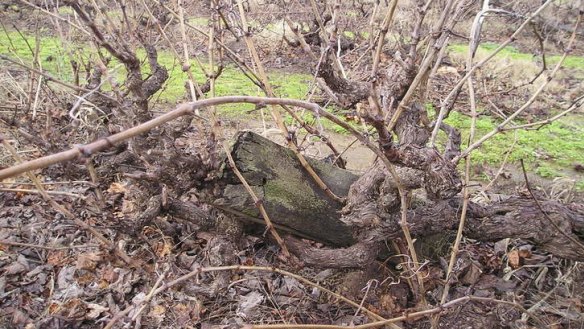Venerable survivor
Mourvedre is a tough variety to get to grips with.

The release of the 2011 Penfolds Shiraz Mourvedre Bin 2, an old label from the 1960s resurrected in the 1990s, and a ''March mataro madness'' campaign by Barossa wine merchant David Farmer beg the question of what this great old variety really is. Not much of it is grown in Australia - in 2008, just 785 hectares, mostly in the Barossa Valley - yet it has survived here since the 1830s. And even if we've not heard of it, we've almost certainly enjoyed mourvedre (aka mataro), acknowledged or not in red blends or as an anonymous component in Australian ''port''.
Descriptions of mourvedre contradict one another. Can it really be soft and fruity but also tannic and iron-hard; both low in acid with little colour and searingly acidic and opaque? The answer appears to be yes. Consider these contrasting accounts of Spanish and Australian mourvedre/monastrell/mataro from Jancis Robinson's The Oxford Companion to Wine and Rolf Binder's Veritas Winery website.
Jancis Robinson: ''The wine produced from monastrell's small, sweet, thick-skinned berries tends to be heady stuff, high in alcohol, tannins and a somewhat gamey, almost animal flavour.'' Rolf Binder: ''A mataro berry is about 1.5 times larger than a shiraz berry, so bleeding off juice increases the juice-to-skin ratio.'' In short, Binder bleeds juice off to increase extraction of tannin and colour, something his Spanish peers don't need to do.
Robinson also writes that in southern France ''mourvedre is considered an improving structural ingredient - a sort of vinous RSJ'' - suggesting its firm tannins give the backbone lacking in the companion varieties, shiraz, grenache and cinsault.
Barossa vigneron Dean Hewitson offers two possible reasons for southern French mourvedre's comparative toughness. The first, and most likely, he believes, is that varieties are mixed in the vineyard in the Rhone Valley but they ripen at different times. Therefore, if a grower harvests a plot of ripe grenache, the mourvedre mixed with it will be unripe, with hard tannins. The second is that the devastation of European vineyards by phylloxera in the late 19th century might have resulted in significant clonal differences between Australia and Europe. Barossa plantings are all pre-phylloxera and may be ''clonally softer in tannin'', Hewitson suggests.
Penfolds' comments based on Barossa fruit seem more in line with Robinson's. Penfolds says, ''Mourvedre is dark in colour, smells of Provencal herbs and spices and has plenty of tannin stuffing. This is a wine varietal greatly valued by Penfolds winemakers for its blending attributes; toning down the exuberant qualities of shiraz, while adding overall complexity and palate grip.''
Because mourvedre buds and ripens very late, it needs plenty of late-season heat. Little wonder, then, it's at home in the hot Barossa and Spain, but pushes only into southern France, and even there can struggle to ripen.
In Australia, as in France and Spain, mourvedre plays mainly a support role to other varieties, historically for ''port'' and increasingly for red table wine. In the mid-'80s, the so-called Rhone Rangers led the Barossa revival of grenache-shiraz-mourvedre blends. This group, including Charlie Melton, Rocky O'Callaghan and Bob McLean, Chris Ringland and Rolf Binder, took the unique beauty of the Barossa's very old vines to the world.
Mourvedre played a key role in the blends. But they weren't the first to gain recognition, as Penfolds Shiraz Mataro Bin 2, made from 1960, remained popular until its discontinuation in the 1970s. Penfolds resurrected it in 1980 and 1981, then discontinued it, shipping the remainder to Britain. Production of Bin 2, now labelled as shiraz mourvedre, began again in 1990.
Mourvedre seems set to continue its supporting role to shiraz and grenache. But Hewitson and Binder have both made jaw-dropping straight varietals as thrilling as any red on the market.
Hewitson believes we'll see more straight mourvedre in the near future. He suspects recent sales of Baby Bush and Old Garden to fellow Barossa makers are for them to benchmark their own products.
We'll have to wait and see. But even if more flow into the market, it'll be a tiny volume. Mourvedre accounts for less than 1 per cent of Australia's red plantings, and these vines produce only 6000 tonnes to 7000 tonnes of grapes a year.
Production might be small, but it's a key variety, a great blender, sensational on its own on occasion and now, I'm told, the best grapes fetch very high prices. In the Barossa, this means a small army of makers, many of them quite small, hunting down those very special, very old parcels.
On glug.com.au, David Farmer notes the long history of the variety in the Barossa Valley and warm inland regions. He warns of the marketing danger of using two names for the one variety, especially given the difficulty of pronouncing ''mourvedre'' and the much longer usage of ''mataro'' in Australia.
Farmer notes that of the 43 straight or blended mataros listed on the Dan Murphy's website, 20 use ''mataro'', 22 use ''mourvedre'' and one uses the Spanish, ''monastrell''. Clearly, winemakers remain split on which name to use, though I suspect the pendulum has swung to ''mourvedre'', especially among the young.
Call it what we will, mourvedre remains an important niche variety.